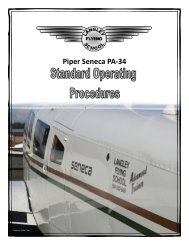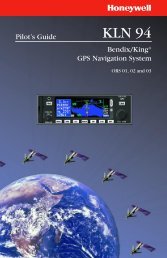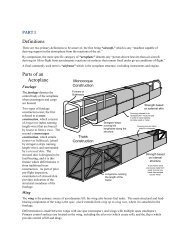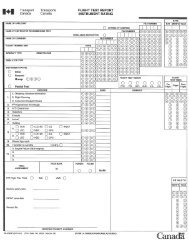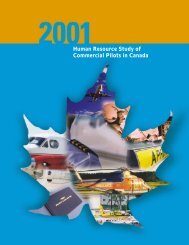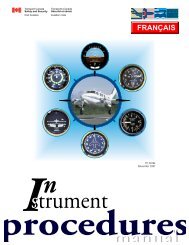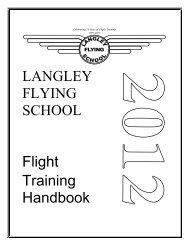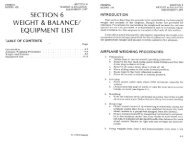Langley Flying School Private Pilot Groundschool Manual Sample ...
Langley Flying School Private Pilot Groundschool Manual Sample ...
Langley Flying School Private Pilot Groundschool Manual Sample ...
You also want an ePaper? Increase the reach of your titles
YUMPU automatically turns print PDFs into web optimized ePapers that Google loves.
<strong>Private</strong> and Recreational <strong>Pilot</strong> <strong>Groundschool</strong> <strong>Manual</strong> Page 51<strong>Langley</strong> <strong>Flying</strong> <strong>School</strong>, Inc.Angle of Bank in Level Flight0 o Bank 20 o Bank 40 o Bank 60 o Bank 80 o BankLoading: 1.0 g Loading: 1.06 g Loading: 1.31 g Loading: 2.0 g Loading: 5.75 gAerodynamic Weight:2000 lbs.Stall Speed: 55 KTSAerodynamic Weight:2100 lbs.Stall Speed: 56.6 KTSAerodynamic Weight:2620 lbs.Stall Speed: 63 KTSAerodynamic Weight:4000 lbs.Stall Speed: 78 KTSAerodynamic Weight:11,500 lbs.Stall Speed: 132 KTSTurnsLIFTWEIGHTDuring a turn in level flight, greater lift is required tooffset increased effective aerodynamic weight of theaircraft in the turn. Because the angle of attack of anaircraft must be increased to offset the increasedaerodynamic weight (resultant force of a turn), the wingis closer to the critical angle of attack and therefore closerto a stall, despite a constant airspeed. Accordingly, thereis an increase in the relative stall speed of an aircraft in alevel turn. The formula to determine increased stallspeed is as follows: normal stalling speed times thesquare root of the load factor equals banked stall speed.Thus, an aircraft with a stall speed of 50 KTS and in a60-bank turn (load factor of 2.0) will stall at 71 KTS.FlapsLIFTWEIGHTVERTICALCOMPONENT OF LIFT(effective lift)CENTRIFUGALFORCERESULTANTFORCEAn increase in airfoil lift isproduced by the use ofSimple Flapflaps, and the stall speed isdecreased by their useSlotted Flap(bottom of white line on anAirspeed Indicator). TheSplit Flapextension of flaps has theeffect of increasing therelative angle of attack ofFlowler Flapthe airfoil. Induced drag isalso increased. Some flap designs incorporated slots,which permit the compressed air under the wing tomigrate through the slot to the upper surface of the flaps.These are referred to as slotted flaps. Some flap designsallow the flap surface to move rearward as it extends—the feature is referred to as a Fowler Flap.SpinsSpinning is defined as autorotation that develops after an aggravated stall (a wing dropping during a stall).The downward moving wing has a higher angle of attack and more induced drag than the upward moving wing andtherefore acquires a greater stalled condition. Spinning involves simultaneous roll, yaw and pitch as it develops ahelical or corkscrew path nose down.An incipient spin is the autorotation prior to a vertical descent path, while a fully developed spin begins once the© 2012 David L. Parry



